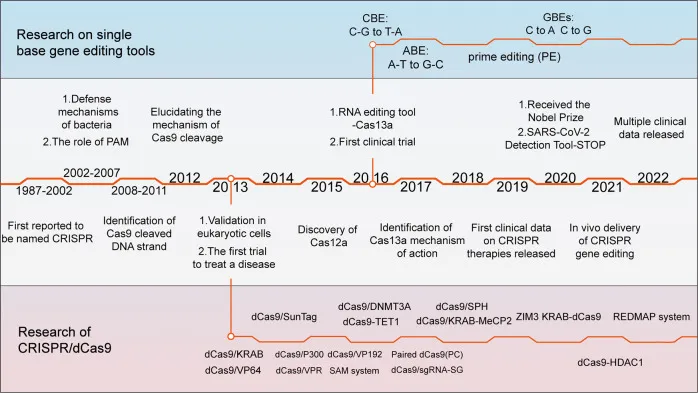The definition of synthetic biology is to use engineering ideas to modularize or create biological cells, enabling them to have the ability to synthesize compounds. Generalized synthetic biology actually refers to the extension of a series of downstream technologies based on DNA editing technology, including microbial metabolic engineering, enzyme engineering, gene editing services, cell therapy and gene therapy, artificial cell meat, and other fields. Generally speaking, synthetic organisms use modified cells to produce substances. Synthetic biology is a typical interdisciplinary field that is based on engineering (circuit and electronic engineering) ideas, combined with genetic technology, computer technology, fermentation production technology, and chemical engineering and process technology, to form a new cell workshop production plan. Synthetic biology is an “ancient” and “emerging” discipline. Synthetic biology, as an underlying technology, can be widely applied in downstream industries, including food, daily chemical, agriculture, environment, energy, medical and many other fields.

Figure 1-1 Industrial Scale Applications of Synthetic Biology (Rohini Keshava, et al. 2018)
Development History of Synthetic Biology
Synthetic biology is not actually a completely emerging technology, and it has also been highlighted throughout history. In ancient times, humans discovered that stacked fruits, grains, etc. emitted a “intoxicating aroma” and utilized this phenomenon. After optimizing the process, they obtained the technology of brewing. Afterwards, humans continuously invented condiments such as vinegar, soy sauce, and soy sauce, which were referred to as the “fermentation phenomenon” and were the earliest synthetic organisms. However, in ancient times, due to the limitations of science and technology, humans were unable to fundamentally understand the “fermentation phenomenon”. In fact, fermentation is the phenomenon of microorganisms producing metabolic products after reproduction, which is the embryonic stage of synthetic organisms.
In 1674, Leeuwenhoek invented the world’s first optical microscope and used it to observe the microscopic world for the first time. For the first time, humans realized that the “fermentation phenomenon” was actually the action of microorganisms, and from then on, synthetic organisms entered the stage of micromation. With the deepening of human understanding of the micro world, humans have begun to master pure bacterial culture techniques. In 1928, British man A. Fleming discovered in a plate culture dish for cultivating Staphylococcus that there was no growth of Staphylococcus around the contaminated Penicillium, forming a sterile circle. After the discovery of penicillin, due to the limitations of the extraction process, its quality is unstable, the yield is extremely low, and the price is expensive. After the outbreak of the Second World War, it objectively put forward urgent needs for the prevention and treatment of infectious diseases. In 1942, Florey and Chain collaborated with Pfizer in the United States to break through the deep fermentation technology of penicillin, greatly increasing its production and yield, making penicillin a popular drug and saving countless lives. During the same period, the fermentation production of organic acids, amino acids, and other industries also flourished.
In 1953, Francis Crick and James D. Watson discovered the double helix structure of DNA, marking the beginning of the era of molecular biology. DNA, as a genetic material, can control physiological activities such as growth, development, and reproduction of organisms, which is why scientists have officially begun their research on DNA. Synthetic organisms have officially developed from microscopic to directional stages. With the development of three major technologies: gene sequencing, gene editing, and gene synthesis, humans have gradually mastered the technology of targeted modification of organisms and applied it commercially. In 1972, Tu Youyou’s research team isolated and purified the effective antimalarial monomer artemisinin from the effective part of Artemisia annua. However, due to technological limitations, the content of this substance in Artemisia annua is extremely low and does not meet the conditions for large-scale production. China has been paying attention to chemical synthesis methods for producing artemisinin since the 1980s. In early 1984, academician Zhou Weishan of the Chinese Academy of Sciences led researchers to achieve the artificial total synthesis of artemisinin. Unfortunately, this achievement has not yet achieved industrial production. In April 2006, scientists at the University of California, Berkeley in the United States successfully synthesized the precursor of artemisinin – artemisinin acid – by transferring some important genes in the biosynthesis pathway of artemisinin, such as the sophora diene synthase gene and the sophora diene hydroxylase gene, into engineering yeast. Although the production is still relatively low, there is significant room for technological progress. Sanofi Company has obtained the authorization for yeast engineering bacteria fermentation to produce artemisinin. By the end of 2012, 39 tons of artemisinin had been produced, which was converted into artemisinin, equivalent to 40 million doses of antimalarial drugs. The chemical synthesis of natural products is a major challenge in the chemical industry, while plant extraction relies on traditional agricultural cultivation and plant extraction. Synthetic biology is considered the most promising direction for solving the large-scale production of natural products. Although synthetic organisms are not yet technologically mature, both the scientific and technological community, the capital community, and governments around the world have seen the enormous potential of synthetic organisms.
The research on the underlying technology of synthetic biology has not stopped at the three major technologies of genes. In areas such as systems biology, omics, and protein engineering, synthetic biology has also begun to undergo extensive interdisciplinary research. In protein engineering, AI machine learning technology is applied to simulate protein folding, deeply empowering enzyme modification and protein drug design; In omics, techniques in mathematical statistics have also been applied, enabling large-scale data statistics and calculations to study the laws of cell life activities. In the future, synthetic organisms will develop towards systematization and are expected to fully achieve low-cost and efficient production of various compounds.

Figure 1-2 History of Synthetic Biology









